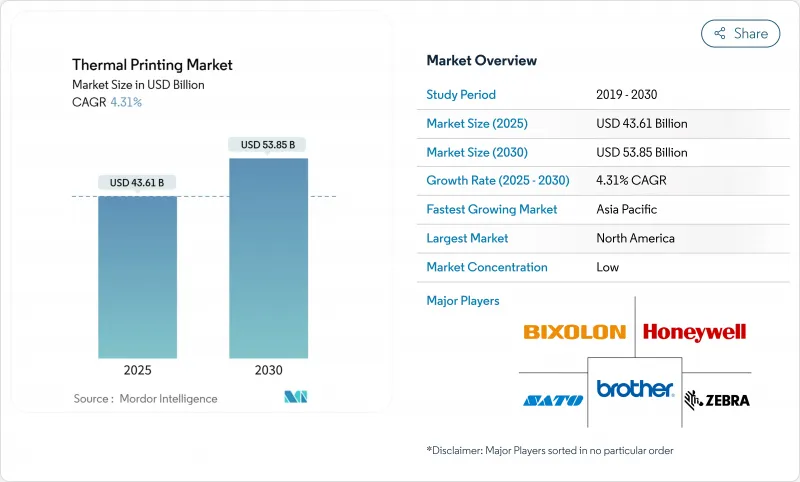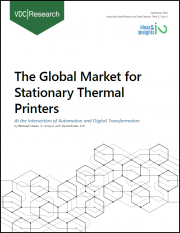
|
시장보고서
상품코드
1851158
서멀 프린트 시장 : 시장 점유율 분석, 산업 동향, 통계, 성장 예측(2025-2030년)Thermal Printing - Market Share Analysis, Industry Trends & Statistics, Growth Forecasts (2025 - 2030) |
||||||
서멀 프린트 시장 규모는 2025년에 436억 1,000만 달러로 추정되고, 2030년에는 538억 5,000만 달러에 이를 것으로 예측되며, 예측 기간 중 CAGR 4.31%로 성장이 전망됩니다.

지속적인 기세는 헬스케어 직렬화 규칙, 전자상거래 소포량, 온디맨드 라벨에 의존하는 산업 자동화 프로그램 때문입니다. 비스페놀 A 및 기타 페놀을 금지하는 규제의 움직임은 배합 시프트를 가속시키는 방아쇠가 되었지만, 적합 미디어의 선택이 계속 확대되고 있기 때문에 전체적인 인쇄량은 감소하지 않았습니다. IoT 지원 프린트헤드, 원격 플릿 관리 소프트웨어, RFID 내장 라벨 워크플로우의 발전은 커넥티드 공급망 내에서 기술의 관련성을 강화하고 있습니다. 한편, 잉크젯 및 레이저 시스템은 에너지 및 소모품 비용이 높기 때문에 연간 수백만 점의 상품을 출하, 재고, 추적하는 대량 생산 사업에 있어서 서멀 출력은 매력적이 되고 있습니다. 선도적인 공급업체가 아시아태평양 공장에 투자하면 다국적 고객이 탄력적인 공급 네트워크를 찾고 있는 가운데 세계적인 생산 능력이 아시아태평양에 결정적으로 기울어지고 있음을 보여줍니다.
세계의 서멀 프린트 시장 동향 및 인사이트
AIDC 채용 및 전자상거래 물류 붐
2027년 GS1 기한을 앞두고 2차원 바코드로의 전환을 진행하는 소포 사업자는 보다 고해상도의 QR 출력에 대응하기 위해 차량을 갱신하고 있으며, 라벨이 없는 반품 프로그램이 전개되어도 하드웨어의 매출을 유지하고 있습니다. 경력 평가판에 따르면 주문 수가 200% 증가하는 피크 시즌에는 서멀 라벨 수량이 급증하고 실시간으로 라벨을 생성하여 수동 병목 현상을 방지하고 있습니다. 소매업체는 또한 어두운 상점에 클라우드에 연결된 모바일 프린터를 배포하고 피킹 라벨을 일괄 인쇄하여 온라인 주문 시스템과 마지막 원 마일리지 택배 업체 간의 데이터 갭을 해소합니다. 이러한 시장 개척으로 서멀 프린트 시장은 옴니채널 물류의 워크플로우에 확실히 통합되고 있습니다. 마지막으로 물류 허브는 프린트 서버를 창고 실행 소프트웨어와 통합하여 주문 루트를 기반으로 자동 프린터 할당을 가능하게 하고 가동 중단 위험을 줄입니다.
무선 및 모바일 서멀 프린터 확대
새로운 Wi-Fi 6 지원 모델은 데이터 처리량을 두 배로 늘리고 로밍 드롭을 줄여 피커가 수천 평방미터에 이르는 야드를 이동하는 동안에도 중단 없이 라벨에 액세스할 수 있습니다. 연속 가동 배터리는 더블 시프트 전체를 지원하게 되었고, 한때 왕로의 도크를 정지시켰던 주간의 재충전 휴식이 감소되었습니다. 라이너리스 기능은 미디어 낭비를 50% 줄이고 지속가능성 감사원에게도 기뻐하며 효과적인 롤 용량을 증가시켰습니다. SATO의 모바일 관리 시스템과 같은 원격 관리 대시보드는 미디어 수준의 감소와 헤드 온도의 이상을 IT 팀에 경고하여 현장 방문 빈도를 낮추고 있습니다. 플릿 데이터는 또한 고장이 발생하기 전에 교환을 스케줄링하는 예측 분석 모델에 공급되어 물류 센터 내의 전반적인 장비의 효율성 지표를 향상시킵니다.
높은 수리비 및 헤드 교환비
서멀 헤드는 여전히 가장 비싼 소모품이며, 종종 신품 유닛의 30% 가격으로 판매됩니다. 복잡한 스마트 프린터에는 공장에서 숙련된 기술자를 필요로 하는 보안 요소와 IoT 모듈이 내장되어 있어 인건비가 부과됩니다. 소규모 소매업체는 고장이 긴급 구매를 강요받을 때까지 유지 보수를 지연시켜 새로 고침 일정을 악화시키고 있습니다. 공급업체는 단단한 코팅과 빠른 스왑 카세트를 사용하여 작업자가 공구 없이 헤드를 교체할 수 있게 하여 다운타임을 몇 분으로 단축합니다. 디바이스의 펌웨어에 내장된 예측 서비스 알고리즘도 바코드의 어두움이 스캐너 임계값 아래로 떨어지기 전에 고장을 예측하지만, 이러한 업그레이드는 선행 취득 가격을 상승시키기 때문에 예산에 제약이 있는 분야에서는 도입이 지연될 수 있습니다.
부문 분석
소매업체, 제조업체 및 물류 허브는 자동화된 워크플로우를 통해 상품을 이동하기 위해 표준화된 1차원 및 2차원 코드에 의존하기 때문에 바코드 인쇄는 최대 지위를 유지하며 2024년 서멀 프린트 시장 점유율의 40.21%를 차지했습니다. 이 부문 시장 규모는 GS1의 세계 무결성, 규제 시리얼화 의무, 소모품의 저비용에 의해 보호되고 있으며, 디지털 변혁에 의해 일부 거래가 온라인화 되더라도 리프레시 수요는 안정적입니다.
전반적인 서멀 프린트 시장 규모 중에서 모바일 핸드헬드 프린팅은 2025-2030년 연평균 복합 성장률(CAGR) 7.34%로 확대될 것으로 예측됩니다. Wi-Fi 6 연결, 긴 수명 배터리, 라이너리스 미디어 옵션은 가동 중지 시간과 낭비를 줄이고 이동 경로를 줄이고 작업 생산성을 높이는 벨트 장착형 장치로 고정 키오스크를 교체하도록 촉구합니다.
Direct Thermal은 2024년에 47.54%의 점유율을 차지했으며, 12개월 미만의 스캐너빌리티가 허용되는 짧은 수명 선적 라벨로 중심 지위를 강화합니다. 염료 확산 열전사는 현재 틈새 시장이지만 헬스케어 장비 및 고급 패키징이 선명한 컬러 그라데이션과 사진 품질 그래픽을 필요로 하기 때문에 2030년까지 연평균 복합 성장률(CAGR)은 5.54%에 달할 전망입니다.
다이렉트 서멀은 리본을 사용하지 않고, 움직이는 부품도 적으며, 간단하기 때문에 취득 비용과 유지관리 비용을 낮게 억제해, 최소한의 감시로 높은 인쇄 사이클을 유지할 수 있습니다. 그러나 자외선에 노출되면 이미지가 어두워지거나 냉동실에서 퇴색될 수 있으므로 실외나 빙점 아래 환경에서의 사용이 제한됩니다. 열전사는 왁스, 왁스 수지 또는 수지 잉크를 필름 형상의 페이스 스톡에 도포하는 것으로, 스틸제 스톡룸, 전기 라벨링, 오토클레이브 멸균을 실시하는 실험용 바이알 등에 필요한 내상성이나 내약품성을 실현합니다. 새로운 하이브리드 디바이스는 소프트웨어로 모드를 전환할 수 있기 때문에 창고에서는 경제적인 다이렉트 서멀 방식을 발송 소포에 사용하거나 수명 5년의 자산 태그에 견고한 수지 리본을 사용할 수 있습니다. R2 = 0.9916의 정확도 점수로 검증된 머신러닝 지원으로 인클레이 다운 튜닝은 미스 프린트를 줄이고 헤드 수명을 연장합니다. 반면에 페놀이 없는 탑코트 조사는 미디어 공장과 프린터 OEM의 협력을 촉진하여 헤드의 조기 마모를 방지하는 히트 프로파일 캘리브레이션을 가능하게 했습니다. 이러한 혁신을 통해 서멀 프린트 시장은 빠르게 움직이는 소비재에서 미션 크리티컬 산업 분야에 이르기까지 광범위한 시장을 유지하고 있습니다.
서멀 프린트 시장 보고서는 용도별(바코드, 라벨, POS 및 영수증, 기타), 인쇄 기술별(다이렉트 서멀, 열전사, 염료 확산 열전사), 포맷 유형별(산업용, 기타), 최종 이용 산업별(소매 및 전자상거래, 운송 및 물류, 제조 및 창고, 기타), 지역별(북미, 유럽, 아시아태평양, 남미, 중동 및 아프리카)로 구분됩니다.
지역 분석
북미는 엄격한 헬스케어 규제, 광범위한 창고 자동화, 데이터 풍부한 QR 및 RFID 라벨링의 높은 채택으로 2024년 매출의 35.65%를 차지했습니다. 연방 정부의 추적성 의무화로 병원과 제약회사는 규격이 진화하자마자 프린터를 갱신하게 되고, 다점포 전개하는 소매업체는 수백 점포에 이르는 플릿을 최적화하는 엔터프라이즈급 관리 스위트를 표준화하고 있습니다. 팬데믹(세계적 유행) 이후, 전자상거래의 취급량은 증가의 길을 따라갑니다.
유럽은 에코디자인 규제와 페놀에 대한 소비자의 반발에 힘입어 비스페놀 프리 미디어에 대한 연구개발 투자를 추진하고 상당한 점유율을 차지하고 있습니다. 이 지역에서는 폐기물 감축 지침 및 탄소 실적 목표를 충족하기 위해 라이너리스 채택이 지원됩니다. 독일 및 북유럽 국가 제조업체는 OPC-UA 게이트웨이를 사용하여 라벨 데이터를 디지털 트윈에 직접 공급하고 배치 계통도를 작성하여 프린터를 Industry 4.0 스택에 통합합니다. 프린트 헤드의 건전성을 실시간으로 모니터링하는 것은 이 지역의 스마트 공장에서 널리 사용되는 예지 보전 전략과 일치합니다.
중국, 인도, ASEAN의 물류업체가 현장에서 라벨을 생성해야 하는 고밀도 라스트마일 네트워크를 구축하고 있기 때문입니다. 엡손의 아키타 프린트헤드 공장이 생산능력을 3배로 증강하는 등의 투자는 일본의 업스트림 부품 통합이 지역 수요 증가에 대응하고 있음을 보여줍니다. 국내 프린터 브랜드는 낮은 인건비를 활용하여 가격에 민감한 중소기업을 도입하는 반면 다국적 3PL은 세계 고객의 SLA를 충족하기 위해 엔터프라이즈급 장비를 수입하고 있습니다. 인도의 통일 물류 인터페이스 플랫폼(ULIP)과 같은 정부 프로젝트는 항만과 철도의 바코드 표준화를 촉진하고 대응 가능한 기반을 더욱 확대하고 있습니다. 중동 및 아프리카와 남미는 소매업의 근대화와 공공안전기관에 의한 자산 추적의 디지털화에 따라, 규모에서는 후진을 숭배하고 있는 것, 꾸준한 확대를 기록하고 있습니다. 그러나 환율 변동으로 인해 갱신 속도가 둔화되기 때문에 공급업체는 자본 투자를 여러 해 계약에 분산시키는 구독 모델을 제공합니다.
기타 혜택 :
- 엑셀 형식 시장 예측(ME) 시트
- 3개월간의 애널리스트 서포트
목차
제1장 서론
- 조사의 전제조건 및 시장 정의
- 조사 범위
제2장 조사 방법
제3장 주요 요약
제4장 시장 상황
- 시장 개요
- 시장 성장 촉진요인
- AIDC 채용 및 전자상거래 물류 붐
- 무선 서멀 프린터 및 모바일 서멀 프린터의 확대
- 대량 라벨을 위한 잉크젯 및 레이저에 대한 비용 우위성
- 증가하는 헬스케어 규정 준수 표시 요구
- 라이너리스 미디어 및 BPA 프리 미디어의 지속가능성 추진
- 실시간 추적을 위한 콜드체인 IoT 통합
- 시장 성장 억제요인
- 높은 수리비 및 헤드 교환비
- RFID 및 디지털 영수증 도입에 의한 경쟁
- BPA 및 페놀 규제에 의한 미디어 비용 상승
- 펄프 가격의 변동이 종이 공급 혼란 초래
- 공급망 분석
- 규제 상황
- 기술의 전망
- Porter's Five Forces 분석
- 신규 참가업체의 위협
- 구매자의 협상력
- 공급기업의 협상력
- 대체품의 위협
- 경쟁 기업 간 경쟁 관계
- 투자 분석
제5장 시장 규모 및 성장 예측
- 용도별
- 바코드
- POS 및 영수증
- 라벨
- 카드
- RFID
- 키오스크 및 티켓
- 모바일(핸드헬드)
- 인쇄 기술별
- 다이렉트 서멀(DT)
- 열전사(TT)
- 염료 확산 열전사(D2T2)
- 포맷별
- 산업
- 데스크톱
- 모바일
- 최종 이용 산업별
- 소매 및 전자상거래
- 운송 및 물류
- 제조 및 창고
- 헬스케어 및 의약품
- 정부 및 공공안전
- 접객 및 엔터테인먼트
- 은행 및 금융 서비스
- 지역별
- 북미
- 미국
- 캐나다
- 멕시코
- 유럽
- 독일
- 영국
- 프랑스
- 이탈리아
- 스페인
- 러시아
- 기타 유럽
- 아시아태평양
- 중국
- 일본
- 인도
- 한국
- ASEAN
- 기타 아시아태평양
- 중동 및 아프리카
- 중동
- 사우디아라비아
- 아랍에미리트(UAE)
- 튀르키예
- 기타 중동
- 아프리카
- 남아프리카
- 나이지리아
- 기타 아프리카
- 남미
- 브라질
- 아르헨티나
- 기타 남미
- 북미
제6장 경쟁 구도
- 시장 집중도
- 전략적 동향
- 시장 점유율 분석
- 기업 프로파일
- Zebra Technologies
- SATO Holdings
- Toshiba TEC
- Honeywell International
- Brother Industries
- Star Micronics
- Seiko Instruments
- Citizen Systems
- Fujitsu Frontech
- Epson
- BIXOLON
- TSC Auto ID
- Printronix Auto ID
- Avery Dennison
- Evolis
- Axiohm
- CognitiveTPG
- Dymo(Newell)
- Posiflex Technology
- Xiamen Rongta Technology
제7장 시장 기회 및 향후 전망
AJY 25.11.12The thermal printing market size is valued at USD 43.61 billion in 2025 and is projected to reach USD 53.85 billion by 2030, translating into a 4.31% CAGR across the period.

Sustained momentum comes from healthcare serialization rules, e-commerce parcel volumes, and industrial automation programs that rely on on-demand labels. Regulatory moves banning bisphenol-A and other phenols have triggered accelerated formulation shifts but have not diminished overall print volumes because compliant media options continue to expand. Advancements in IoT-ready printheads, remote fleet management software, and RFID-embedded label workflows strengthen the technology's relevance inside connected supply chains. Meanwhile, the higher cost of energy and consumables for inkjet or laser systems keeps thermal output attractive for high-volume businesses that ship, stock, or track millions of items annually. Investments by leading vendors in Asia-Pacific factories underline a decisive tilt of global capacity toward the region as multinational customers search for resilient supply networks.
Global Thermal Printing Market Trends and Insights
Adoption of AIDC and E-commerce Logistics Boom
Parcel operators shifting to two-dimensional barcodes ahead of the 2027 GS1 deadline are refreshing fleets to support higher-resolution QR output, sustaining hardware sales even as label-free returns programs roll out. Carrier trials show that thermal label volumes spike during peak seasons when order counts climb by 200% and real-time label generation prevents manual bottlenecks. Retailers also deploy cloud-linked mobile printers inside dark stores to print batch pick labels, closing data gaps between online order systems and last-mile couriers. These developments keep the thermal printing market firmly embedded in omnichannel logistics workflows. Finally, logistics hubs integrate print servers with warehouse execution software, allowing automatic printer allocation based on order routes and mitigating downtime risk.
Expansion of Wireless and Mobile Thermal Printers
New Wi-Fi 6-enabled models double data-throughput and reduce roaming drops, giving pickers uninterrupted label access while traveling across yards that span thousands of square meters. Continuous-run batteries now support an entire double shift, cutting mid-day recharge breaks that once halted outbound docks. Linerless capability trims media waste by 50%, pleasing sustainability auditors and raising effective roll capacity. Remote-management dashboards, such as SATO's Mobile Management System, alert IT teams to low media levels and head temperature anomalies, lowering field visit frequency. Fleet data also feeds predictive analytics models that schedule swap-outs before failures occur, raising overall equipment effectiveness metrics inside distribution centers.
High Repair and Head-replacement Costs
Thermal heads remain the most expensive consumable, often priced at 30% of a new unit, and intensive industrial users still swap them yearly. Complex smart printers embed secure elements and IoT modules that require factory-trained technicians, inflating labor bills. Smaller retailers defer maintenance until failures force emergency purchases, dampening refresh schedules. Vendors answer with harder coatings and quick-swap cassettes that let operators change heads without tools, reducing downtime to minutes. Predictive service algorithms embedded in device firmware also forecast failures before barcode darkness falls below scanner thresholds, though such upgrades increase upfront acquisition prices and may slow adoption in budget-constrained sectors.
Other drivers and restraints analyzed in the detailed report include:
- Cost-advantage Over Inkjet/Laser for High-volume Labels
- Growing Healthcare Compliance Labelling Needs
- Competition from RFID and Digital Receipt Adoption
For complete list of drivers and restraints, kindly check the Table Of Contents.
Segment Analysis
Barcode printing retained the largest position, accounting for 40.21% of thermal printing market share in 2024 as retailers, manufacturers, and logistics hubs relied on standardized one- and two-dimensional codes to move goods through automated workflows. The segment's scale is protected by global GS1 alignment, regulatory serialization mandates, and the low cost of consumables, keeping refresh demand stable even as digital transformation shifts some transactions online.
Within the overall thermal printing market size, mobile hand-held printing is projected to expand at a 7.34% CAGR from 2025 to 2030 because warehouse pickers, field technicians, and curbside grocery runners need real-time labels at the item level. Wi-Fi 6 connectivity, longer-life batteries, and linerless media options reduce downtime and waste, encouraging enterprises to replace fixed kiosks with belt-worn units that shorten travel paths and boost task productivity.
Direct thermal claimed 47.54% share in 2024, reinforcing its central place in short-life shipping labels where scannability under 12 months is acceptable. Dye-diffusion thermal transfer, although niche today, posts a 5.54% CAGR through 2030 as healthcare devices and luxury packaging require crisp color gradients and photo-quality graphics.
Direct thermal's simplicity-no ribbon, fewer moving parts-keeps acquisition and maintenance costs low, supporting high print cycles with minimal oversight. However, images can darken under UV exposure or fade in freezers, limiting usage in outdoor or sub-zero settings. Thermal transfer applies wax, wax-resin, or resin ink to filmic facestocks, achieving scratch and chemical resistance needed in steel stockrooms, electrical labeling, and laboratory vials that undergo autoclave sterilization. Emerging hybrid devices switch between modes via software, allowing warehouses to use economical direct thermal for outbound parcels and rugged resin ribbons for asset tags with 5-year life mandates. Machine-learning-assisted ink laydown tuning, verified by an R2 = 0.9916 accuracy score, reduces misprints and extends head life. Meanwhile, research into phenol-free top-coats spurs collaboration between media mills and printer OEMs to calibrate heat profiles that prevent premature head wear. These innovations ensure the thermal printing market maintains breadth across fast-moving consumer goods and mission-critical industrial contexts alike.
The Thermal Printing Market Report is Segmented by Application (Barcode, Label, POS / Receipt, and More ), Printing Technology (Direct Thermal, Thermal Transfer, Dye Diffusion Thermal Transfer), Format Type (Industrial, and More), End-Use Industry (Retail and E-Commerce, Transportation and Logistics, Manufacturing and Warehouse and More), and Geography (North America, Europe, Asia-Pacific, South America, Middle-East and Africa).
Geography Analysis
North America accounted for 35.65% of revenue in 2024 thanks to strict healthcare regulations, extensive warehouse automation, and high adoption of data-rich QR and RFID labelling. Federal traceability mandates ensure hospitals and pharmaceutical firms refresh printers as soon as standards evolve, and multi-site retailers standardize on enterprise-class management suites that optimize fleets across hundreds of stores. E-commerce volumes remain elevated post-pandemic, keeping parcel hubs focussed on rugged high-throughput units.
Europe follows with a sizable share, underpinned by eco-design regulations and consumer pushback against phenols, propelling R&D investments in bisphenol-free media. The region champions linerless adoption to satisfy waste-reduction directives and carbon-footprint goals. Manufacturers in Germany and the Nordic countries integrate printers with Industry 4.0 stacks, using OPC-UA gateways to feed label data directly into digital twins for batch genealogy. Real-time monitoring of printhead health aligns with predictive maintenance strategies prevalent in the region's smart factories.
Asia-Pacific is the fastest-growing slice, forecast at a 6.25% CAGR, as Chinese, Indian, and ASEAN logistics carriers build dense last-mile networks that require on-the-spot label generation. Investments like Epson's Akita printhead plant, tripling capacity, indicate upstream component consolidation in Japan serving rising regional demand. Domestic printer brands leverage lower labor costs to capture price-sensitive SMEs, while multinational 3PLs import enterprise-grade devices to satisfy global customer SLAs. Government projects such as India's Unified Logistics Interface Platform (ULIP) encourage barcode standardization across ports and railroads, further widening the addressable base. Middle East and Africa and South America trail in scale but register steady expansion as retail modernizes and public safety digitizes asset tracking; currency volatility, however, slows refresh cadence, prompting vendors to offer subscription models that spread capex over multi-year contracts.
List of Companies Covered in this Report:
- Zebra Technologies
- SATO Holdings
- Toshiba TEC
- Honeywell International
- Brother Industries
- Star Micronics
- Seiko Instruments
- Citizen Systems
- Fujitsu Frontech
- Epson
- BIXOLON
- TSC Auto ID
- Printronix Auto ID
- Avery Dennison
- Evolis
- Axiohm
- CognitiveTPG
- Dymo (Newell)
- Posiflex Technology
- Xiamen Rongta Technology
Additional Benefits:
- The market estimate (ME) sheet in Excel format
- 3 months of analyst support
TABLE OF CONTENTS
1 INTRODUCTION
- 1.1 Study Assumptions and Market Definition
- 1.2 Scope of the Study
2 RESEARCH METHODOLOGY
3 Executive Summary
4 Market Landscape
- 4.1 Market Overview
- 4.2 Market Drivers
- 4.2.1 Adoption of AIDC and e-commerce logistics boom
- 4.2.2 Expansion of wireless and mobile thermal printers
- 4.2.3 Cost-advantage over inkjet/laser for high-volume labels
- 4.2.4 Growing healthcare compliance labelling needs
- 4.2.5 Sustainability push for liner-less and BPA-free media
- 4.2.6 Cold-chain IoT integration for real-time tracking
- 4.3 Market Restraints
- 4.3.1 High repair and head-replacement costs
- 4.3.2 Competition from RFID and digital receipt adoption
- 4.3.3 BPA/phenol regulations raising media costs
- 4.3.4 Pulp-price volatility disrupting paper supply
- 4.4 Supply-Chain Analysis
- 4.5 Regulatory Landscape
- 4.6 Technological Outlook
- 4.7 Porter's Five Forces Analysis
- 4.7.1 Threat of New Entrants
- 4.7.2 Bargaining Power of Buyers
- 4.7.3 Bargaining Power of Suppliers
- 4.7.4 Threat of Substitutes
- 4.7.5 Competitive Rivalry
- 4.8 Investment Analysis
5 MARKET SIZE AND GROWTH FORECASTS (VALUE)
- 5.1 By Application
- 5.1.1 Barcode
- 5.1.2 POS / Receipt
- 5.1.3 Label
- 5.1.4 Card
- 5.1.5 RFID
- 5.1.6 Kiosk and Ticket
- 5.1.7 Mobile (hand-held)
- 5.2 By Printing Technology
- 5.2.1 Direct Thermal (DT)
- 5.2.2 Thermal Transfer (TT)
- 5.2.3 Dye Diffusion Thermal Transfer (D2T2)
- 5.3 By Format Type
- 5.3.1 Industrial
- 5.3.2 Desktop
- 5.3.3 Mobile
- 5.4 By End-Use Industry
- 5.4.1 Retail and E-commerce
- 5.4.2 Transportation and Logistics
- 5.4.3 Manufacturing and Warehouse
- 5.4.4 Healthcare and Pharma
- 5.4.5 Government and Public Safety
- 5.4.6 Hospitality and Entertainment
- 5.4.7 Banking and Financial Services
- 5.5 Geography
- 5.5.1 North America
- 5.5.1.1 United States
- 5.5.1.2 Canada
- 5.5.1.3 Mexico
- 5.5.2 Europe
- 5.5.2.1 Germany
- 5.5.2.2 United Kingdom
- 5.5.2.3 France
- 5.5.2.4 Italy
- 5.5.2.5 Spain
- 5.5.2.6 Russia
- 5.5.2.7 Rest of Europe
- 5.5.3 Asia-Pacific
- 5.5.3.1 China
- 5.5.3.2 Japan
- 5.5.3.3 India
- 5.5.3.4 South Korea
- 5.5.3.5 ASEAN
- 5.5.3.6 Rest of Asia-Pacific
- 5.5.4 Middle East and Africa
- 5.5.4.1 Middle East
- 5.5.4.1.1 Saudi Arabia
- 5.5.4.1.2 United Arab Emirates
- 5.5.4.1.3 Turkey
- 5.5.4.1.4 Rest of Middle East
- 5.5.4.2 Africa
- 5.5.4.2.1 South Africa
- 5.5.4.2.2 Nigeria
- 5.5.4.2.3 Rest of Africa
- 5.5.5 South America
- 5.5.5.1 Brazil
- 5.5.5.2 Argentina
- 5.5.5.3 Rest of South America
- 5.5.1 North America
6 COMPETITIVE LANDSCAPE
- 6.1 Market Concentration
- 6.2 Strategic Moves
- 6.3 Market Share Analysis
- 6.4 Company Profiles (includes Global level Overview, Market level overview, Core Segments, Financials as available, Strategic Information, Market Rank/Share for key companies, Products and Services, and Recent Developments)
- 6.4.1 Zebra Technologies
- 6.4.2 SATO Holdings
- 6.4.3 Toshiba TEC
- 6.4.4 Honeywell International
- 6.4.5 Brother Industries
- 6.4.6 Star Micronics
- 6.4.7 Seiko Instruments
- 6.4.8 Citizen Systems
- 6.4.9 Fujitsu Frontech
- 6.4.10 Epson
- 6.4.11 BIXOLON
- 6.4.12 TSC Auto ID
- 6.4.13 Printronix Auto ID
- 6.4.14 Avery Dennison
- 6.4.15 Evolis
- 6.4.16 Axiohm
- 6.4.17 CognitiveTPG
- 6.4.18 Dymo (Newell)
- 6.4.19 Posiflex Technology
- 6.4.20 Xiamen Rongta Technology
7 MARKET OPPORTUNITIES AND FUTURE OUTLOOK
- 7.1 White-space and Unmet-need Assessment



















